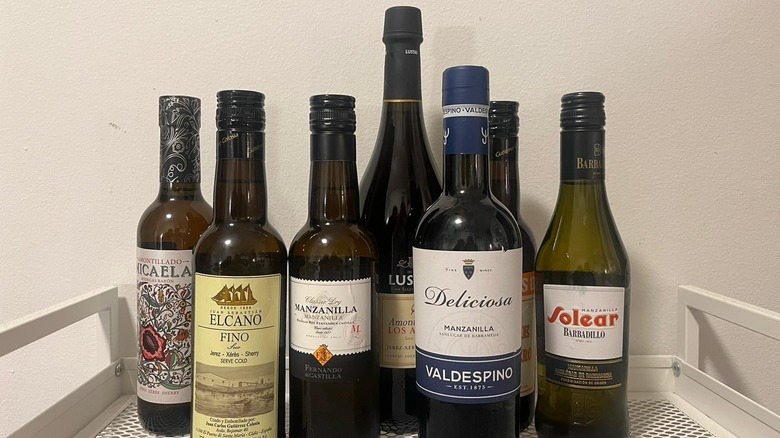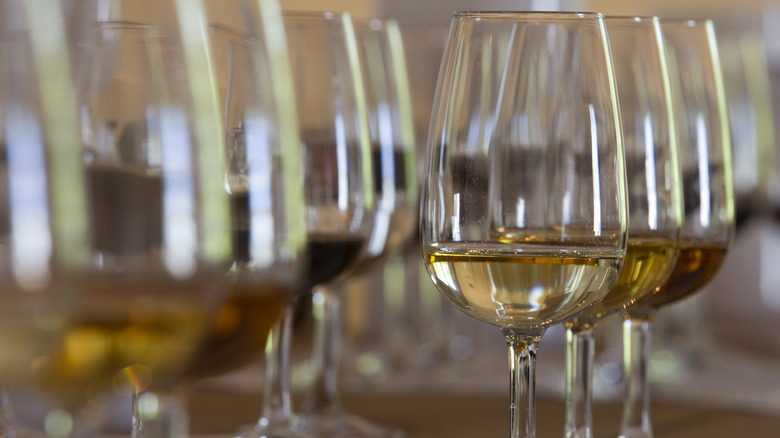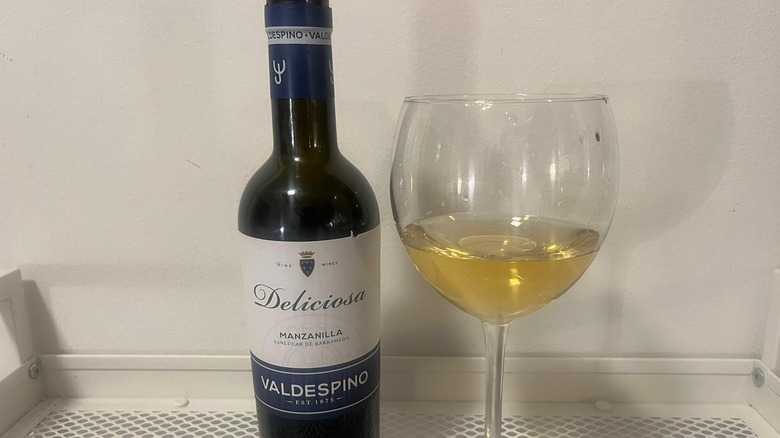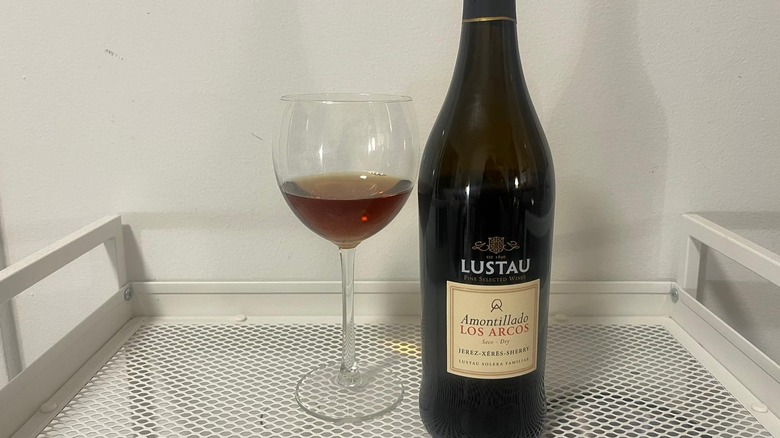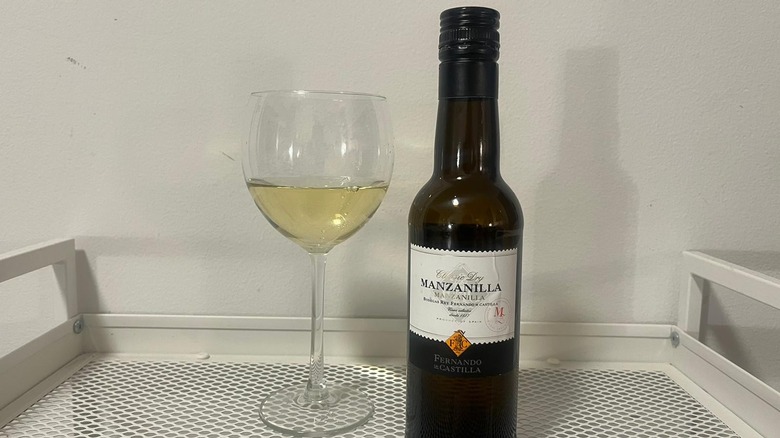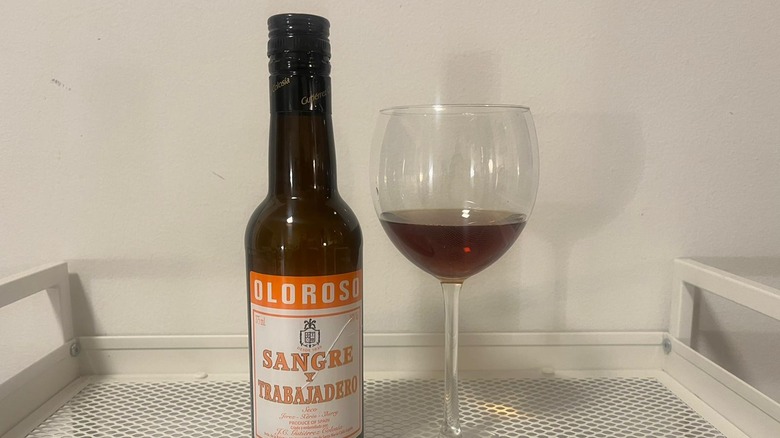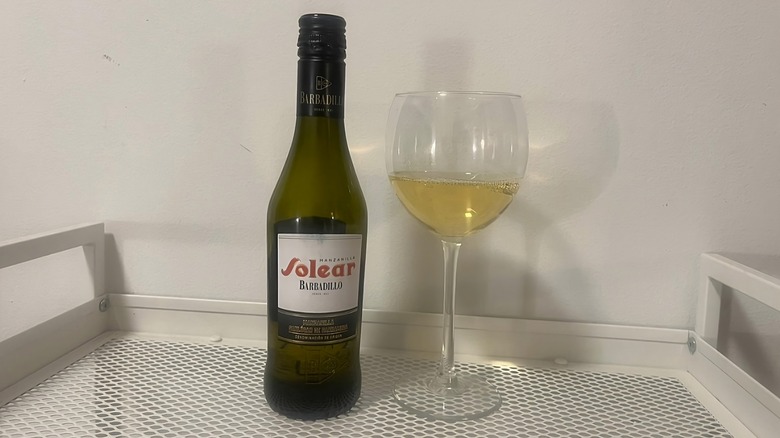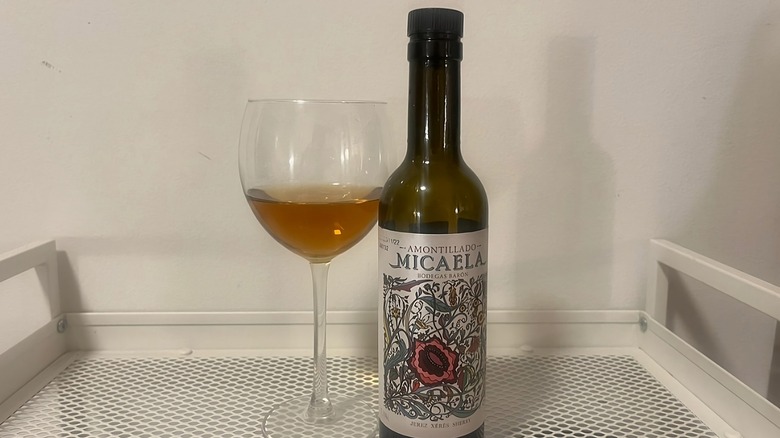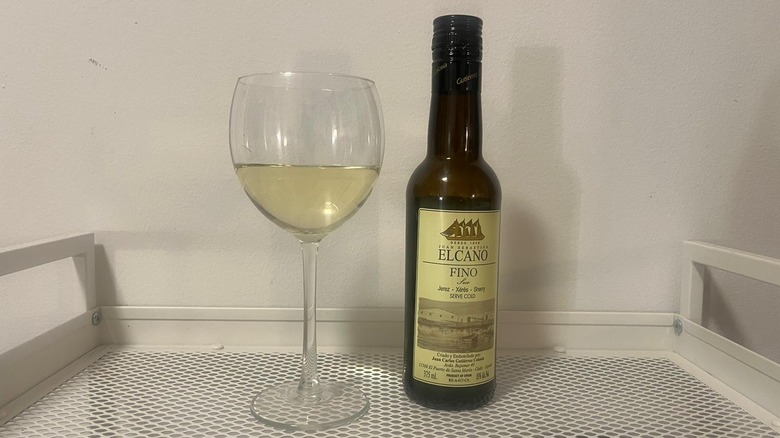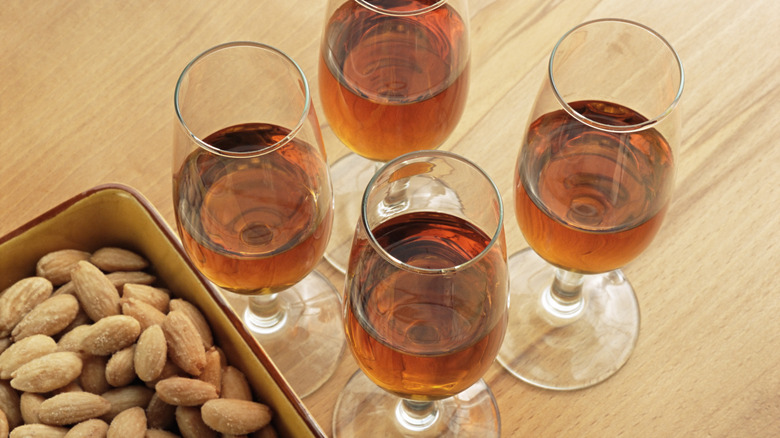7 Sherry Wines, Ranked
Sherry is one of a handful of wines that incite a knee-jerk reaction. Associations with Grandma's liquor cabinet or Wild West saloons have kept this wine from the spotlight for decades. But sherry is experiencing a buzzy, beautiful new era as the fortified wine crops up across wine lists and cocktail menus nationwide. But if you want to enjoy sherry at home by investing in a bottle, you may still be wondering where to start. To help navigate this peculiar beverage, we tested and ranked seven sherry wines.
I myself am a deeply devoted sherry drinker. It's the perfect choice when all the other items on a drink list are overpriced (for example, the popular NYC spot Dante sells its cocktails for sometimes over $20, but you can enjoy the historic ambiance over a glass of sherry for only $8), and tastes great alone or with light bites. To create this list, I visited the sherry section at Astor Wines & Spirits, an expansive and historic wine shop in Manhattan's Greenwich Village.
The sherries selected on this list were chosen for two particular reasons. First, I wanted the bottles to all be reasonably priced. Each on the list costs under $20, because unless you're a sherry connoisseur, it's hard to justify a higher per-bottle price point. Additionally, I chose several types of sherry, including amontillado and manzanilla, to give insight into multiple varieties of sherry styles. Thus, each wine was smelled and tasted, resulting in this ranking of sherry wines.
What is sherry wine?
Before getting into the ranking of various brands and styles of sherry, it is important to understand what, exactly, distinguishes sherry from other kinds of wine. At its simplest, sherry is a fortified wine (meaning it has been distilled with a spirit to make it stronger) hailing from the Andalusian region of Spain. It is aged white wine made from one of three varieties of green grapes — palomino, moscatel, and pedro ximénez — and the color of sherry can vary from pale gold to a rich brown. Flor is an important aspect of the sherry-making process; it is the naturally forming yeast film that tops the wine and gives it its distinct taste. Sherry is also sometimes compared to Champagne in that you can really taste the wine-making that goes into every glass.
There are seven types of sherry wine that are produced. An imbiber may see manzanilla, which can only be made in the coastal town Sanlucar de Barrameda, fino, the most "classic" sherry flavor and the most common, amontillado, a hybrid style, or the full-bodied oloroso, commonly in wine shops. Two other styles, cream sherry and pedro ximénez, are often served in a dessert context. Palo cortado, the seventh type, is a rare and poorly understood variety of sherry in which the flor disappears without a clear explanation. The wines on this list include manzanillas, amontillados, oloroso, and fino. For a full rundown on the fortified wine, read this guide to sherry.
7. Valdespino Deliciosa Manzanilla
Pulling up the rear of the ranking of seven kinds of sherry wine is the brand Valdespino's manzanilla, called "Deliciosa." Delicious, unfortunately, it was not. Valdespino is a sherry producer that dates back to the 1400s or even earlier, and certainly has its share of worthwhile products. However this manzanilla style sherry was watery and opened up poorly, revealing a burnt smell that leaves the drinker reeling.
Manzanilla sherry wines are characterized by their seaside qualities: One should smell and taste the special town, Sanlucar de Barrameda, that alone can produce manzanilla. While this sherry did evoke the sea, it skewed more toward low-tide brine than salty brightness. Though certain elements of the flavor profile were pleasing, like its initial smell of yeast and the light note of fruit and Marcona almonds, the smell, to say nothing of the taste, became almost actively unpleasant after only a few minutes of exposure to the air. With a taste that veered a bit watery, complemented by a singed smell, this sherry fell flat. And perhaps worst of all, instead of feeling light on the palate, it came off lacking in crispness and complexity.
6. Lustau Los Arcos Amontillado
Opening a nice amontillado should involve smells that are complex, delivering a rich blend of nuttiness, tobacco, and wood on the nose. This heady scent profile should be matched by a general complexity of taste, with flavors in the vein of dried fruit, hazelnuts, roasted nuts, sea salt, and even caramel. What this amontillado from Lustau achieves is nowhere near this benchmark. While you initially get a dried fruit quality on the nose, as well as a bit of Madeira, that other perennially popular dessert wine, the actual taste is quite rich but without substantial nuttiness.
There also seems to be an abrasive quality to the "Los Arcos" that comes off as a high alcohol content. At 18%, it isn't an unusually high ABV, as amontillados can reach up to 22%. However, this Coke-brown sherry is a tad one-note and just a little bitter, emphasizing the alcohol over any initial richness or fruitiness. In a word, Lustau's amontillado is, unfortunately, lackluster.
5. Fernando de Castilla Classic Dry Manzanilla
While the Fernando de Castilla manzanilla appears in the latter half of this ranking, it was, in some ways, an exceptionally interesting sherry-drinking experience. As has been established, manzanillas have a unique seaside quality due to the coastal location in which they must be produced. This sherry did evoke one aspect of the coastal experience, as it smelled strongly, and right away, of tanning lotion. It had a powerful tropical scent composed of artificial coconut, but also playground wood chips and lime Skittles, all of which proved intriguing but made me wary to actually taste it. Not that the scent was unpleasant, it was just incredibly distinct and ever so slightly plastic-forward.
The flavor of this sherry did satisfy the requisite nut factor, but quite lightly. It was a subtle pureed hazelnut note, with a slight yesterday's-lemon flavor. Overall, this manzanilla had high acid, making it a somewhat crisper choice than the Valdespino offering in the same style. The tropical aroma feels a little too put on to take seriously, but if you want to have an interesting manzanilla experience to accompany your seafood or appetizers, you could do a lot worse.
4. Gutierrez Colosia Oloroso Sangre y Trabajadero
The oloroso style of sherry is known for its darker color, full-bodied complexity, and nutty smoothness. The oloroso from Gutierrez Colosia is a nice, inoffensive introduction to the style. Gutierrez Colosia, the producer, has been established since 1838 and is the only producer in the area located riverside, a location that the brand says provides the wine-making process with a more regulated moisture level. On the nose, this sherry provides notes of cola, artificial banana (think Laffy Taffy), tame fig, and just a hint of that tanning oil tropicality. Somehow surpassing all of these elements, this sherry smells most of all like a rum and Coke cocktail.
The taste here may be slightly less impressive than the smell. Fig and cashews are the dominant flavors in this dry sherry (that can initially hint at being sweet), and you get just a whisper of those tropical and seaside flavors you pick up on via scent. If you pick some of this sherry, which runs around $19.99 a bottle, try pairing it with tapas like a good Spanish cheese (possibly manchego) or snacks that are both sweet and salty. You can also take a look at these exceptional Spanish dishes that are primed for the pairing.
3. Barbadillo Solear Manzanilla
For a sherry that's full of warming cheer, look no further than this manzanilla style offering from Barbadillo. What constitutes this comforting sensation? Upon first sniff, the sherry smells like Werther's Original caramels or a classic butterscotch. Aged for an impressive six years, it also has aromatic notes of over-ripe fruit like guava, and the lushness of a slow-churned caramel ice cream.
This confectionery quality is matched by a vibrant yet still old-fashioned array of flavors. This sherry offers the brightness of a golden apple and a slight kinship to apple juice. At the same time, it has a bit of saltiness that is complemented by its savory notes of peanut and walnut. This wine lacks just a bit of the complexity and elegance of the later entries on this list, but it is worth noting that the sherry has the distinction of landing a spot on Wine Spectator's list of the top 100 wines in the world in 2019, a rarity for sherry and Spanish wines. So the next time you entertain, start guests off with tapas and this flor-forward sherry, or serve it with a seafood paella main course for a foolproof pairing.
2. Bodegas Baron Micaela Amontillado
First-time sherry drinkers will get a massive treat when trying out Bodegas Baron's amontillado. The 400-year-old producer specializes in manzanilla, but this "Micaela" amontillado is a great demonstration of its widespread expertise. It has quite a dark color and smells of molasses and dark caramel (as opposed to something like a Werther's Original candy). As far as its nutty aroma goes, there is a delicious pecan scent, and on the fruit front, a figgy strain. The smell, as lovely as it is, doesn't have a massive scope beyond the molasses confection vibe, withholding it from the top spot on the list.
The taste, however, is remarkably delicious and complex. First, you'll get some cashew that builds upon the pecan already established. The element of baked, dried, and otherwise spiced fruit and baked goods is the real standout flavor. With all the warming and sentiment of a fruit cake but without the cloying component, this sherry finishes with a subtle nuttiness. The "Micaela" has been aged for three to four years on average, and it goes great with anchovies, cured meats, and briny olives. This olive-topped Mediterranean pasta dish would make a great dinner companion for this exceptional sherry.
1. Gutierrez Calaso Elcano Fino
The best sherry of the selected seven undoubtedly goes to Gutierrez Calaso's "Elcano" Fino. The wine is so pale gold it should serve as an indicator of the subtle beauty of the sherry's aroma and flavor. The smell has a waxy quality to it, one of marzipan and other light almond treats. That being said, it also delivers a slight floral scent akin to chamomile, all while being perhaps the most distinctly wine-smelling entry on the list.
When it comes time to sip, the "Elcano" has a delightfully surprising dose of sea salt. The floral note is expanded upon as white flowers like peony come through in harmony with an orange blossom undercurrent. You will still get some yeast, like a delicious bread crust, and the nuttiness (specifically salted almonds) isn't lost either. This sherry is elegant and a perfect choice to pair with food with a little edge — spicy or smoked nuts (like these crispy herbed almonds) and other tapas are a natural fit.
Methodology
Passions surrounding wine can be intense, so there are probably a million potential ways to select, test, and rank something so historically rich and currently relevant as sherry. For the purposes of this ranking, two main factors were considered: accessibility and variety. The first point concerns the price of the sherry. It is, overall, a more affordable alcoholic beverage choice, but I still sought out bottles priced near or under $20 to reflect the wines one is most likely to pick out without having extensive knowledge of sherry. Additionally, because there are seven varieties of sherry, I wanted to hit at more than half of those. Because cream sherry and pedro ximénez are quite dessert-oriented, and because palo cortado is such a rare variety, I found that centering the other four was the most relevant reflection of which kinds of sherries people drink today.
I taste-tested each sherry, grouping the wines by type. I tasted the amontillados together, as well as the manzanillas, and then the others individually. In between sips, I had water and a sniff of coffee beans for a quick palate cleanse. Thai allowed me to compare tastes quite directly, while mitigating some of the risk of one sherry bleeding into the next.
